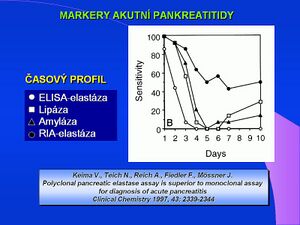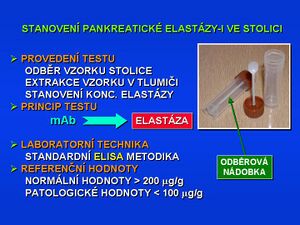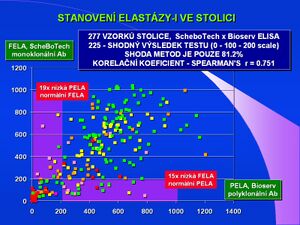Pankreatická elastáza
O správnosti tohoto článku se vede polemika – blíže v diskusi
Elastáza-1 (EC 3.4.21.11) je secernována jako proelastáza a aktivována trypsinem. Rozlišujeme elastázu-1 (Mr 30000; anodická frakce), která se vyskytuje v séru ve volné formě a v komplexu s a1-proteinázovým inhibitorem, a elastázu-2 (Mr 25000; katodická frakce). Enzym je secernován pankreatickou šťávou do duodena a během střevní pasáže není degradována proteinová sekvence zvolená pro immunochemickou detekci. Při zánětlivých procesech dochází také k retrográdnímu uvolnění do krevního oběhu a kvantifikace sérové hladiny lidské pankreatické elastázy je vhodným markerem akutní pankreatitidy, např. post-ERCP, a karcinomu pankreatu. Elastáza-1 (stanovená ELISA technikou) má ze všech pankreatických enzymů pro karcinom pankreatu nejvyšší specificitu i sensitivitu. Hladina elastázy-1 je zvýšena u akutní i chronické recidivující pankreatitidy, přičemž zvýšení přetrvává déle a lépe koreluje s klinickým stavem než hladina α-amylázy. Ke stanovení elastázy-1 se používá RIA metody se 125I-značenou elastázou nebo novějších ELISA technik s monoklonální protilátkou k elastáze-1. Elastáza-1 (stanovená ELISA technikou) má ze všech pankreatických enzymů pro karcinom pankreatu nejvyšší specificitu i sensitivitu. Referenční rozmezí (pro RIA metodiku) je 1.3–4.3 µg/l. Nejnovější studie stanovení sérové elastázy 1 je založena na latexové immunoassay.
Stanovení elastázy-1 (EL-1) ve stolici[upravit | editovat zdroj]
Lidská pankreatická elastáza 1 je syntetizována acinárními buňkami pankreatu. Enzym je secernován pankreatickou šťávou do duodena a během střevní pasáže není degradována proteinová sekvence zvolená pro immunochemickou detekci. Stanovení elastázy vykazuje proto vyšší dg. přínos, na rozdíl od chromogenní metody stanovení chymotrypsinu ve stolici, význam nemá ani stanovení lipázy ve stolici. Aktivita lidské pankreatické elastázy 1 ve vzorcích stolice odráží míru exokrinní pankreatické funkce. Nejnovější aplikace doporučují stanovení pankreatické elastázy-1 v duodenální šťávě při stimulovaném funkčním testu. Klinický význam má stanovení elastázy-1 ve stolici v diferenciální diagnostice malabsorpčního syndromu, jako screeningový test onemocnění pankreatu a pro dlouhodobé sledování nemocných s chronickou pankreatitídou.
Laboratorní metoda je založena na imunologickém průkazu ELISA metodou s monoklonální (nebo polyklonální) protilátkou k lidské, pankreatické elastáze. Vzorek stolice je v laboratoři homogenizován v extrakčním nárazníkovém roztoku a po ředění 1:500 dále zpracován běžným ELISA postupem na mikrotitrační destičce s detekcí pomocí POD-streptavidin. Souprava obsahuje 5 kalibračních standardů v rozmezí 0.3–10.0 ng/ml.
Referenční hodnoty jsou 200–500 µg/g stolice, hraniční pásmo je 100–200 µg/g, závažná pankreatická insuficience je stanovena při hodnotách < 100µg/g stolice. Imunochemické stanovení elastázy-1 není ovlivněno pasáží tlustým střevem, substituční terapií ani jinými faktory, které ovlivňují enzymové stanovení chymotrypsinu ve stolici. Specificita metody je 93%, senzitivita dosahuje pro těžkou pankreatickou insuficienci hodnoty 100%, pro střední a lehké formy 87%. Tento test je běžně používán v pediatrii k průkazu cystické fibrózy se specificitou i senzitivitou téměř 100%. Falešná snížená hodnota může být způsobena zředěním (obsahem vody) při průjmu.
Odkazy[upravit | editovat zdroj]
Použitá literatura[upravit | editovat zdroj]
- KAPETANOS, D, et al. The value of serum amylase and elastase measurements in the prediction of post-ERCP acute pancreatitis. Hepatogastroenterology. 2007, vol. 54, no. 74, s. 556-60, ISSN 0172-6390. PMID: 17523321.
- WU, D, et al. Evaluating the role of serum elastase 1 in the diagnosis of pancreatic cancer. Chin J Dig Dis. 2006, vol. 7, no. 2, s. 117-20, ISSN 1443-9611 (Print), 1443-9573 (Electronic). PMID: 16643340.
- WILSON, RB, et al. Serum elastase in the diagnosis of acute pancreatitis: a prospective study. ANZ J Surg. 2005, vol. 75, no. 3, s. 152-6, ISSN 1445-1433 (Print), 1445-2197 (Electronic). PMID: 15777396.
- KEIM, V, et al. Evaluation of Pankrin, a new serum test for diagnosis of acute pancreatitis. Clin Chim Acta. 2003, vol. 332, no. 1-2, s. 45-50, ISSN 0009-8981 (Print), 1873-3492 (Electronic). PMID: 12763279.
- KATSANOS, KH, et al. The true value of serum elastase-1 in endoscopic retrograde cholangiopancreatography (ERCP). Eur J Intern Med. 2002, vol. 13, no. 5, s. 329-335, ISSN 0953-6205 (Print), 1879-0828 (Electronic). PMID: 12144913.
- OHDE, K, et al. Determination of elastase 1 in plasma or serum by latex turbidometric immunoassay with automatic analyzer. Rinsho Byori. 2002, vol. 50, no. 4, s. 376-80, ISSN 0047-1860. PMID: 12014017.
- MILLSON, CE, et al. A prospective study of serum pancreatic elastase-1 in the diagnosis and assessment of acute pancreatitis. Scand J Gastroenterol. 1998, vol. 33, no. 6, s. 664-8, ISSN 0036-5521 (Print), 1502-7708 (Electronic). PMID: 9669641.
- IKEI, S, et al. Blood concentrations of polymorphonuclear leucocyte elastase and interleukin-6 are indicators for the occurrence of multiple organ failures at the early stage of acute pancreatitis. J Gastroenterol Hepatol. 1998, vol. 13, no. 12, s. 1274-83, ISSN 0815-9319 (Print), 1440-1746 (Electronic). PMID: 9918438.
- KEIM, V, et al. Polyclonal pancreatic elastase assay is superior to monoclonal assay for diagnosis of acute pancreatitis. Clin Chem. 1997, vol. 43, no. 12, s. 2339-44, ISSN 0009-9147 (Print), 1530-8561 (Electronic). PMID: 9439452.
- IWASE, K, et al. Serial changes in plasma levels of pancreatic elastase 1 after pancreatic surgeries. Res Exp Med (Berl). 1995, vol. 195, no. 2, s. 93-100, ISSN 0300-9130. PMID: 7659839.
- SATAKE, K, et al. CA19-9 as a screening and diagnostic tool in symptomatic patients: the Japanese experience. Pancreas. 1994, vol. 9, no. 6, s. 703-6, ISSN 0885-3177 (Print), 1536-4828 (Electronic). PMID: 7846012.
- HOMMA, T, et al. The study of the mass screening of persons without symptoms and of the screening of outpatients with gastrointestinal complaints or icterus for pancreatic cancer in Japan, using CA19-9 and elastase-1 or ultrasonography. Int J Pancreatol. 1991, vol. 9, s. 119-24, ISSN 0169-4197. PMID: 1744437.
- LINDER, R, et al. Pancreatic elastase 1 after pancreatic transplantation. Pancreas. 1991, vol. 6, no. 1, s. 31-6, ISSN 0885-3177 (Print), 1536-4828 (Electronic). PMID: 1704632.
- PEZZILLI, R, et al. Serum pancreatic enzymes in the diagnosis of carcinoma of the pancreas. G Ital Oncol. 1989, vol. 9, no. 1, s. 7-13, ISSN 0392-128X. PMID: 2468605.
- TRAN, TC, et al. Pancreatic fibrosis correlates with exocrine pancreatic insufficiency after pancreatoduodenectomy. Dig Surg. 2008, vol. 25, no. 4, s. 311-8, ISSN 0253-4886 (Print). 1421-9883 (Electronic). PMID: 18818498.
- ERICKSON, JA, et al. Evaluation of a fecal pancreatic elastase-1 enzyme-linked immunosorbent assay: Assessment versus an established assay and implication in classifying pancreatic function. Clin Chim Acta. 2008, vol. 397, no. 1-2, s. 87-97, ISSN 0009-8981 (Print), 1873-3492 (Electronic). PMID: 18706899.
- LIEB, JG, et al. Pancreatic function testing: here to stay for the 21st century. World J Gastroenterol. 2008, vol. 14, no. 20, s. 3149-58, ISSN 1007-9327. PMID: 18506918.
- HAHN, JU, et al. Low fecal elastase 1 levels do not indicate exocrine pancreatic insufficiency in type-1 diabetes mellitus. Pancreas. 2008, vol. 36, no. 3, s. 274-8, ISSN 0885-3177 (Print) 1536-4828 (Electronic). PMID: 18362841.
- PEZZILLI, R, et al. Fecal calprotectin and elastase 1 determinations in patients with pancreatic diseases: a possible link between pancreatic insufficiency and intestinal inflammation. J Gastroenterol. 2007, vol. 42, no. 9, s. 754-60, ISSN 0944-1174 (Print), 1435-5922 (Electronic). PMID: 17876545.
- GILLAMS, A, et al. Correlation of MRCP quantification (MRCPQ) with conventional non-invasive pancreatic exocrine function tests. Abdom Imaging. 2008, vol. 33, no. 4, s. 469-73, ISSN 0942-8925 (Print), 1432-0509 (Electronic). PMID: 17653788.
- BOROWITZ, D, et al. Comparison of monoclonal and polyclonal ELISAs for fecal elastase in patients with cystic fibrosis and pancreatic insufficiency. J Pediatr Gastroenterol Nutr. 2007, vol. 44(2):219-23, no. 2, s. 219-23, ISSN 0277-2116 (Print), 1536-4801 (Electronic). PMID: 17255835.
- NARUSE, S, et al. Fecal pancreatic elastase: a reproducible marker for severe exocrine pancreatic insufficiency. J Gastroenterol. 2006, vol. 41, no. 9, s. 901-8, ISSN 0944-1174 (Print), 1435-5922 (Electronic). PMID: 17048055.
- KRECHLER, T, et al. Faecal elastase I--its use in diagnosis of chronic pancreatitis. Cas Lek Cesk. 2006, vol. 145, no. 6, s. 480-3, ISSN 0008-7335. PMID: 16836002.
- SENKAL, M, et al. Pancreatic elastase-1 in the stool for the determination of exocrine pancreas function of postoperative patients with early enteral nutrition -- a pilot study. Dtsch Med Wochenschr. 2006, vol. 131, no. 1-2, s. 13-6, ISSN 0012-0472 (Print), 1439-4413 (Electronic). PMID: 16374736.
- ELPHICK, DA, et al. Comparing the urinary pancreolauryl ratio and faecal elastase-1 as indicators of pancreatic insufficiency in clinical practice. Pancreatology. 2005, vol. 5, no. 2-3, s. 196-200, ISSN 1424-3903 (Print), 1424-3911 (Electronic). PMID: 15849489.
- MOLINARI, I, et al. Fecal chymotrypsin and elastase-1 determination on one single stool collected at random: diagnostic value for exocrine pancreatic status. Clin Biochem. 2004, vol. 37, no. 9, s. 758-63, ISSN 0009-9120 (Print), 1873-2933 (Electronic). PMID: 15329313.
- MIENDJE, Y, et al. Polyclonal versus monoclonal ELISA for the determination of fecal elastase 1: diagnostic value in cystic fibrosis and chronic pancreatic insufficiency. Clin Lab. 2004, vol. 50, no. 7-8, s. 419-24, ISSN 1433-6510. PMID: 15330510.
- STEVENS, T, et al. Analysis of pancreatic elastase-1 concentrations in duodenal aspirates from healthy subjects and patients with chronic pancreatitis. Dig Dis Sci. 2004, vol. 49, no. 9, s. 1405-11, ISSN 0163-2116 (Print), 1573-2568 (Electronic). PMID: 15481311.
- LANKISCH, PG. Now that fecal elastase is available in the United States, should clinicians start using it?. Curr Gastroenterol Rep. 2004, vol. 6, no. 2, s. 126-31, ISSN 1522-8037 (Print), 1534-312X (Electronic). PMID: 15191690.
- BRYDON, WG, et al. Limitations of faecal elastase-1 and chymotrypsin as tests of exocrine pancreatic disease in adults. Ann Clin Biochem. 2004, vol. 41, s. 78-81, ISSN 0004-5632 (Print), 1758-1001 (Electronic). PMID: 14713391.
- HARDT, PD, et al. The commercially available ELISA for pancreatic elastase 1 based on polyclonal antibodies does measure an as yet unknown antigen different from purified elastase 1. Binding studies and clinical use in patients with exocrine pancreatic insufficiency. Z Gastroenterol. 2003, vol. 41, no. 9, s. 903-6, ISSN 0044-2771 (Print), 1439-7803 (Electronic). PMID: 13130326.
- WALKOWIAK, J, et al. Comparison of faecal lipase test and faecal elastase-1 test in the assessment of exocrine pancreatic function in cystic fibrosis. Med Wieku Rozwoj. 2003, vol. 7, no. 2, s. 149-55, ISSN 1428-345X. PMID: 12878785.
- SONWALKAR, SA, et al. A prospective, comparative study of the para-aminobenzoic acid test and faecal elastase 1 in the assessment of exocrine pancreatic function. Aliment Pharmacol Ther. 2003, vol. 17, no. 3, s. 467-71, ISSN 0269-2813 (Print) 1365-2036 (Electronic). PMID: 12562462.
- TAKEDA, M, et al. Fecal elastase-1 test: clinical evaluation of a new noninvasive pancreatic function test. Rinsho Byori. 2002, vol. 50, no. 9, s. 893-8, ISSN 0047-1860. PMID: 12386968.
- WALKOWIAK, J, et al. Fecal elastase-1 is superior to fecal chymotrypsin in the assessment of pancreatic involvement in cystic fibrosis. Pediatrics. 2002, vol. 110, no. 1, s. e7-e7, ISSN 0031-4005 (Print), 1098-4275 (Electronic). PMID: 12093988.
- BEHARRY, S, et al. How useful is fecal pancreatic elastase 1 as a marker of exocrine pancreatic disease?. J Pediatr. 2002, vol. 141, no. 1, s. 84-90, ISSN 0022-3476 (Print), 1097-6833 (Electronic). PMID: 12091856.
- DOMINICI, R, et al. Fecal elastase-1 as a test for pancreatic function: a review. Clin Chem Lab Med. 2002, vol. 40, no. 4, s. 325-32, ISSN 1434-6621. PMID: 12059069.
- LÜTH, S, et al. Fecal elastase-1 determination: 'gold standard' of indirect pancreatic function tests?. Scand J Gastroenterol. 2001, vol. 36, no. 10, s. 1092-9, ISSN 0036-5521(Print), 1502-7708 (Electronic). PMID: 11589385.
- ICKS, A, et al. Low fecal elastase-1 in type I diabetes mellitus. Z Gastroenterol. 2001, vol. 39, no. 10, s. 823-30, ISSN 0044-2771 (Print), 1439-7803 (Electronic). PMID: 11605150.
- CARROCCIO, A, et al. Diagnostic accuracy of fecal elastase 1 assay in patients with pancreatic maldigestion or intestinal malabsorption: a collaborative study of the Italian Society of Pediatric Gastroenterology and Hepatology. Dig Dis Sci. 2001, vol. 46, no. 6, s. 1335-42, ISSN 0163-2116 (Print), 1573-2568 (Electronic). PMID: 11414313.
- NISSLER, K, et al. Pancreatic elastase 1 in feces of preterm and term infants. J Pediatr Gastroenterol Nutr. 2001, vol. 33, no. 1, s. 28-31, ISSN 0277-2116 (Print), 1536-4801 (Electronic). PMID: 11479404.
- LEUS, J, et al. Detection and follow up of exocrine pancreatic insufficiency in cystic fibrosis: a review. Eur J Pediatr. 2000, vol. 159, no. 8, s. 563-8, ISSN 0340-6199 (Print), 1432-1076 (Electronic). PMID: 10968231.
- PHILLIPS, IJ, et al. Faecal elastase 1: a marker of exocrine pancreatic insufficiency in cystic fibrosis. Ann Clin Biochem. 1999, vol. 36, no. 6, s. 739-42, ISSN 0004-5632 (Print), 1758-1001 (Electronic). PMID: 10586310.
- GULLO, L, et al. Fecal elastase 1 determination in chronic pancreatitis. Dig Dis Sci. 1999, vol. 44, no. 1, s. 210-3, ISSN 0163-2116 (Print), 1573-2568 (Electronic). PMID: 9952246.




